
The Navy Department Library
A History of the Dudley Knox Center for Naval History
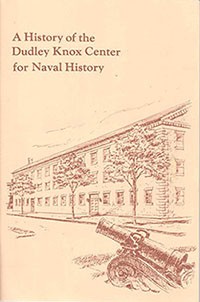
A History of the
Dudley Knox Center
for Naval History
WILLIAM JAMES MORGAN
JOYE L. LEONHART
With an Introduction by
REAR ADMIRAL J.D.H. KANE, JR. USN
(RET.)
Dudley Knox Center for Naval History
Department of the Navy
Washington: 1981
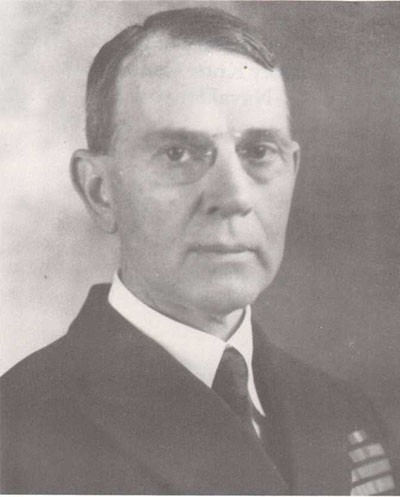
--ii--
INTRODUCTION
No great Things are to be expected at first,
but out of a little a great deal may grow.
John Adams
The intent of this small publication is to enable the reader to trace the course this activity has followed for almost two hundred years since President John Adams sponsored a Navy Department Library to the present Dudley Knox Center for Naval History.
These pages show clearly the impact of Commodore Dudley Knox and the enduring contributions he made to preserve and strengthen the Navy's and Nation's awareness of our inspirational sea heritage.
Also, we have included herein a look at a number of the historic and picturesque buildings in the Washington Navy Yard, some of the scientific achievements which came to fruition in the Yard, as well as a sampling of the epochal events which have unfolded in this time-honored establishment.
It would be remiss of me not to express a special note of appreciation to the Honorable J. William Middendorf II, history-minded sixty-second Secretary of the Navy. Mr. Middendorf's vision, enthusiasm and persuasiveness were instrumental in gaining the support necessary to refurbish this historic complex which now houses the Dudley Knox Center. The Center concept was developed during the tenure of my able predecessor, Vice Admiral Edwin B. Hooper, USN (Ret.).
The Center's multiple resources - library, records, artifacts and art, museum, publications - exist for and are available to serve the Navy, other agencies of government, scholars and the American public. All are invited to enjoy and profit by what the Center has to offer.
JOHN D. H. KANE, JR.
Rear Admiral, USN (Ret.)
Director, Dudley Knox Center for Naval History
SECRETARY OF THE NAVY'S ADVISORY
COMMITTEE ON NAVAL HISTORY
| Francis L. Berkeley, Jr. James A. Field, Jr. Joy Bright Hancock Caryl P. Haskins Forrest C. Pogue |
Jim Dan Hill John H. Kemble Richard W. Leopold Augustus P. Loring |
--iv--
AUTHORS' NOTE
Utilizing available research materials, our assignment was to put together the pieces which would tell the story of how the Dudley Knox Center for Naval History traveled from "there to here." It soon became evident that we had to follow a long twisting road with a number of detours along the way.
Through the years the library, collection and publication of records and other historical activities within the Navy Department were one or more times under the cognizance of the Secretary of the Navy, the Bureau of Navigation, Office of Naval Intelligence and the Chief of Naval Operations. Sometimes all historical functions were combined in one organization, one office name, under one commander and in a single location; sometimes not. Hopefully we have sorted out and presented here briefly the more significant elements in this Center's circuitous and migratory history.
We gratefully acknowledge our debt to Captain John McElroy, USNR, who in 1946 prepared an unpublished study, "Office of Naval Records and Library, 1882-1946." It proved to be a most valuable aid.
William James Morgan
Joye L. Leonhart
--v--
A History of the Dudley Knox Center for Naval History
Early in 1800, Captain Thomas Tingey was ordered to Washington to direct the laying out of the planned navy yard. That same year, President John Adams instructed the first Secretary of the Navy, Benjamin Stoddert, to prepare a catalogue of professional books for use in the Secretary's office. Here was the beginning of the Navy Department Library, and the seedbed from which, in the passage of almost two centuries, has evolved the Dudley Knox Center for Naval History in the Washington Navy Yard as the focal point for the United States Navy's historical programs.
President Adams was precise in specifying what books would be best suited and most useful in a navy library:
It ought to consist of all the best writings in Dutch, Spanish, French, and especially in English, upon the theory and practice of naval architecture, navigation, gunnery, hydraulics, hydrostatics, and all branches of mathematics subservient to the profession of the sea. The lives of all the admirals, English, French, Dutch, or any other nation, who have distinguished themselves by the boldness and success of their navigation, or their gallantry and skill in naval combats.
When the British invading army burned Washington in 1814, the Library's few books and naval records were secreted in trunks and boxes and carried to safety outside the Federal City. Following the War of 1812, the Navy Department, including the Library, occupied a reconstructed two story brick building which became known as the "Old Navy Department Building" at Pennsylvania Avenue and 17th Street, some two hundred yards west of the White House.
The Library grew steadily in the Secretary of the Navy's office. An 1824 catalogue listed 128 titles. By 1882, when the Library was placed under the Bureau of Navigation, Captain John Grimes Walker, Bureau Chief, reported: that there were 7,000 library books. At that point in time, the Library had
--1--
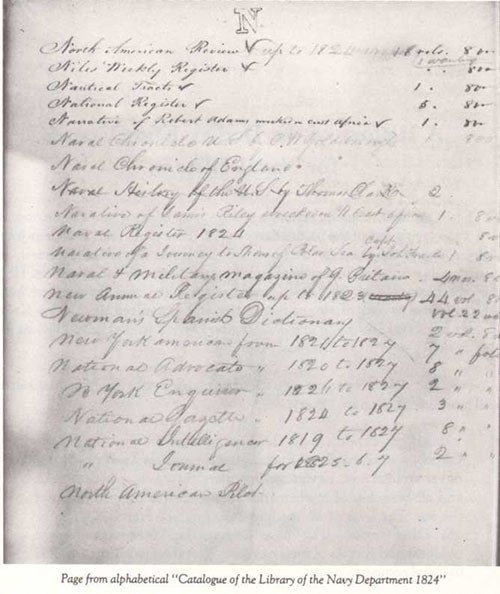
recently moved to the State, War and Navy Building (now the Executive Office Building) on the site of the old Navy Department building. The space in the new quarters occupied by the Library, overlooking the White House grounds and Potomac River, came to be known as the Indian Treaty Room and was classically elegant, "finished and ceiled entirely in iron, and in a most artistic manner. The walls are of iron, inlaid with 32 marble panels. The green marble used in the construction of the panels is malachite, from the Alps; the yellow, sienna, from Italy; and the red, porphyry, from France. The conglomerate is from Lake Champlain. The floor is inlaid with Minton tiling. There are allegorical figures in the corners of the room representing 'War and Peace,' 'Liberty,' 'Industry and Mechanics,' 'Literature, Arts and Commerce.'"
--2--
Through the years, men of high talent have been called to direct the Navy Department Library, not the least of whom was Professor James Russell Soley. He was a prolific writer on naval subjects, an instructor at the Naval Academy, naval officer and a noted international lawyer.
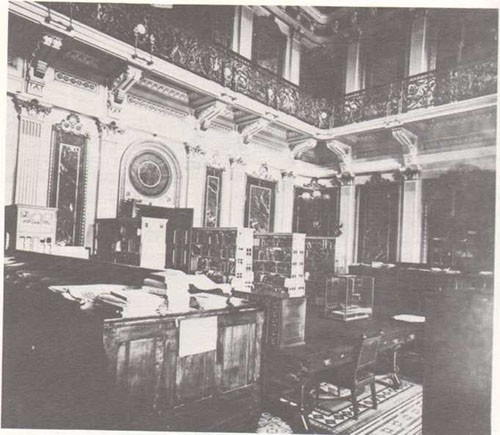
Immediately upon assuming his Library duties in 1882, Soley gathered up the rare books scattered through the various Navy Department offices. He also brought together prints and photographs of naval battles and warships, and entered subscriptions for historical, professional and scientific periodicals. Professor Soley next turned his attention to the matter of naval records.
Early naval records were kept with little system and haphazardly left in the custody of the originating Bureaus, Offices or even individuals. Soley, together with Captain Walker, initiated the first serious attempt to collect and preserve naval records; specifically those of the Civil War. These efforts to search out, bring together, and prepare Civil War records for publication received Congressional recognition in 1884 when $2640 was appropriated to hire one clerk and two copyists. Simultaneously, library and record functions were
--3--
combined under the title of Office of Library and Naval War Records headed by Professor Soley. Secretary of the Navy William C. Whitney in his annual report for 1888 stressed the importance of publishing the Navy's Civil War Documents "which clearly ought to appear side by side with that of the War Department."
Soley became Assistant Secretary of the Navy in 1890, and coincidentally at that time the Office of Library and Naval War Records was transferred from the Bureau of Navigation to the Secretary of the Navy's office. Through Assistant Secretary Soley's efforts, the Library, and records publication project staffs were increased.
In 1894, Congress authorized $15,000 for printing expenses and that very year the first volume of a monumental series, Official Records of the Union and Confederate Navies in the War of the Rebellion, was published. The initial volume contained 890 pages and sold for $1.40 a copy. The series was completed in 1927 with the publication of Volume 31. The Civil War work marked the beginning of a continuing responsibility to collect, edit and publish significant documents bearing on various periods in the U.S. Navy's history; a mission which continues to be carried out today at the Dudley Knox Center for Naval History.
From Soley's time until just prior to World War I, the number of people assigned to the Office of Library and Naval War Records remained virtually constant at 3 library clerks and 14 records clerks. Library and record collection and publication functions were separately funded until a March 1915 legislative
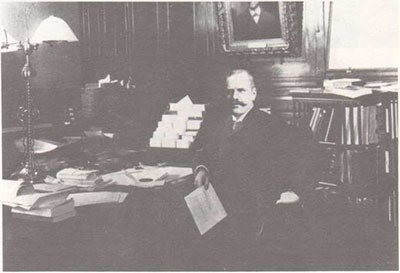
--4--
act consolidated both appropriations, and the office received a new title - Office of Naval Records and Library.
World War I gave impetus to a major turning point in the Navy's historical record collection practices. Heretofore concerned primarily with records from the early period of our naval history, emphasis now shifted to actively gathering data on current naval operations.
Acting under orders from Secretary of the Navy Josephus Daniels and following the lead of Britain's Royal Navy, Admiral William S. Sims, commanding U.S. Naval Forces in Europe, with headquarters in London, formed a Historical Section on his staff to collect war diaries, operational reports and other materials of historical significance. Similarly in Washington, a Historical Section, with interest only in World War I records and as a distinct entity from the Office of Naval Records and Library, was organized within the Office of the Chief of Naval Operations. After the armistice, records assembled by Admiral Sims' people in London were transferred to the Washington-based Historical Section, looking forward to eventual publication. Photographs, illustrating
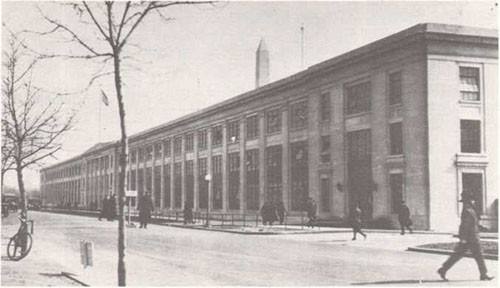
activities of the United States and foreign navies, also formed an important part of the growing World War I collection. The Bureaus and all naval activities were directed to send copies of photos and motion pictures of ships, personnel, bases and incidents taken during the late war to the Historical Section for retention.
The Historical Section, along with the principal offices of the Navy Department, was housed in a new building, Main Navy, on Constitution
--5--
Avenue between 17th and 19th Streets Northwest. The Library, with holdings exceeding 50,000 volumes plus a large collection of "Old Navy" manuscripts and pictures, remained in the ornate State, War and Navy Building for a number of years before being moved to the Main Navy Building in 1923.
Captain (later Commodore) Dudley Knox was ordered to duty as head of both the Office of Naval Records and Library and the Historical Section on 1 August 1921. This officer was to become the driving force of the Navy's historical programs for the next twenty-five years. Knox, an 1896 graduate of the Naval Academy, brought with him to this assignment a keen intellect and recognized reputation as an author as well as a sea officer. He was in London with Admiral Sims during World War I, and was awarded the Navy Cross for "distinguished service in the line of his profession while serving on the Staff of Commander, U.S. Naval Forces Operating in European Waters." The British and Italian governments also honored him with decorations. Returning to the United States, Captain Knox was on the faculty of the Naval War College, commanded USS Brooklyn and USS Charleston, and had a tour in the Office of the Chief of Naval Operations.
Under Captain Knox, archival order was achieved for a heretofore disorganized body of old papers and naval documents. The valuable collection, more than a million items, spanning the beginnings of the Navy to the late 1880s, was the principal depository for original early naval history source material in the country. Knox made the Office of Naval Records and Library, a comparatively little known Navy Department activity, into one of national and international reputation in the field of naval archives and history.
The voluminous World War I records continued to come into the Historical Section and were systematically arranged, forming a ready reference base for information about that war. The Veterans Bureau, for example, made extensive use of these files when adjudicating pension claims. However, plans to publish the World War I records languished because of lack of people and money, and in 1927 the Historical Section was absorbed into the Office of Naval Records and Library.
Another collateral duty fell to Captain Knox in 1930 when the Secretary named him Curator for the Navy Department. He was responsible for collection and preservation of art objects, trophies and relics of historical or inspirational value to the Navy. It was anticipated that this visible display of the nation's sea heritage would soon be seen in Washington in a long-envisioned naval museum. Actually, more than thirty years were to pass before the museum became a reality.
Shortly after his inauguration in 1933, President Franklin Roosevelt, an
--6--
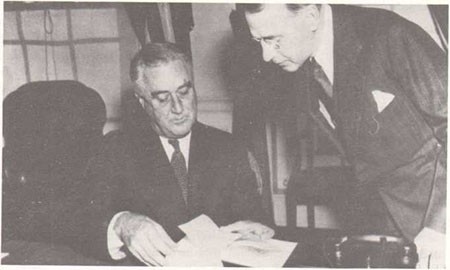
ardent collector and student of naval history, called Captain Knox to the White House. The two had known each other since Roosevelt's tenure as Assistant Secretary of the Navy. At the White House meeting, the President suggested that another early document publication program be initiated, patterned after the Civil War records series. Knox was charged with drawing up a general plan, and at a subsequent meeting the President approved a recommendation that the documents pertaining to the Quasi-War with France be published first. For this purpose, the President requested and received printing funds from Congress.
With the meticulous scholarship and guidance of Captain Knox, seven volumes entitled Naval Documents Related to the Quasi-War Between the United States and France; Naval Operations from February 1797 to December 1801 were published between 1935 and 1938. This was followed from 1939 to 1944 by six volumes, plus a register of officers' and ships' data, of Naval Documents Related to the United States Wars With the Barbary Powers; Naval Operations Including Diplomatic Background from 1785 through 1807. Plans to give similar treatment to the Revolutionary War, War of 1812, and the Mexican War had to be set aside when the Pearl Harbor attack sent the nation into World War II.
Captain Knox's World War I experience in London collecting operational records and his long tour in charge of the Office of Naval Records and Library made him keenly aware that this World War II Navy, operating in two oceans, would generate historically important documentation of a magnitude never before imagined. He immediately urged a systematic survey, collection and
--7--
arrangement of operation plans and orders, action reports, war diaries and patrol reports which would pour into the Navy Department from the active forces. Mass collection of documents by itself was not enough, and Knox stressed that: "The great reservoir of information must be so organized and administered that almost any cross section of data, great or small, that may be called for in the future may be found readily within a reasonable time. Otherwise the information is virtually locked up, with the key lost so far as utility is concerned." Only by bringing the material into a well-conceived archival control system could it be of value for official reference purposes and for naval historians in the present and future.
To staff his embryo war record archives, Knox turned to the academic community and recruited a select group of professional historians to come on board as Naval Reserve officers. Numbered among them was Dr. Walter Muir Whitehill of Harvard University who later co-authored a biography of Fleet Admiral Ernest J. King, and who was for many years chairman of the Secretary of the Navy's Advisory Committee on Naval History. The Knox group, as an adjunct to developing the World War II operational archives, pioneered an oral history program whereby participants in the Pacific and Atlantic were interviewed as soon as possible after significant operations and battles.
One outstanding and tangible result of Captain Knox's farsightedness in gathering and arranging the vital war records was Rear Admiral Samuel Eliot Morison's monumental fifteen volume History of United States Naval Operations in World War II. Morison, Pulitzer Prize winning Harvard professor of history, had suggested to President Roosevelt the desirability of writing a complete and accurate account of the Navy in this global conflict. He was commissioned a Lieutenant Commander in the Naval Reserve and given carte blanche to write the operational history. Although he was on board combat ships and was eyewitness to the North African landings and Pacific sea battles, Morison of necessity relied most heavily on the assembled records Captain Knox's perception made accessible. Within fifteen years after the war, all of Morison's volumes were published - a remarkable achievement.
Secretary of the Navy James Forrestal in July 1944 established an Office of Naval History directly under the Secretary "to coordinate the preparation of all histories and narratives of the current wartime activities in the naval establishment in order to assure adequate coverage to serve present and future needs and effectively to eliminate non-essential and overlapping effort. To initiate and approve essential new projects, amend existing projects, and take whatever steps are necessary to obtain the purposes desired." Admiral Edward C. Kalbfus, USN (Ret.), a member of the General Board, was named to head the new office with the title of Director of Naval History. The Director's
--8--
coordinating authority extended over the Morison work and a World War II administrative history underway. The Office of Naval History was not a part of the Office of Naval Records and Library, although Captain Knox, as additional duty, served as Deputy Director of Naval History under Admiral Kalbfus.
Even before the actual outbreak of hostilities, the quickened tempo and expansion of activities, and increased number of personnel, including activated Naval Reserves, being ordered to staff the offices and Bureaus in Washington, generated an acute space problem for the Navy Department. This had a disruptive impact on the Office of Naval Records and Library which was compelled to move three times in the course of the war.
The first move was from the Main Navy Building to temporary quarters in the National Archives in March 1941. After six months, the next move was to the new Navy Annex in Arlington, Virginia. The Office of Naval Records and Library had hardly settled into the Arlington Annex when encroachments on allotted space were made by departmental activities with higher operational priority. Most of the Library's volumes were then sent to borrowed stack space in the Library of Congress, and the pictorial collection to the care of the Office of Naval Intelligence. The National Archives took permanent legal custody of records in the Office of Naval Records and Library dated prior to 1911, now designated Record Group 45 in the Archives holdings, and agreed to provide wartime storage space for records of later origin.
In August 1945, after the Bureau of Yards and Docks moved to new quarters in Virginia, Captain Knox, his staff and the collected World War II materials returned to the Main Navy Building from Arlington Annex. The Library, however, did not follow until four years later.
The Japanese capitulation, and subsequent drastic reduction of U.S. naval forces afloat and ashore, caused the volume of World War II operational records arriving to be indexed and placed under archival control to reach flood stage. At the same time, the group of highly talented Naval Reserve officers which Knox had assembled was being released from active duty to return to academe. The World War II operational archives thereafter became largely a civilian-manned activity.
An Office of Naval History, as noted previously, had been formed in 1944 in the Secretary's office to coordinate World War II history writing projects. Recommendations to consolidate the Office of Naval History with the Office of Naval Records and Library were implemented in March 1949 when the two were merged as the Naval Records and History Division in the Office of the Chief of Naval Operations.
--9--
The organizational designation remained Naval Records and History until mid-1952 when Rear Admiral John B. Heffernan, then in charge, recommended "Records" be dropped from the title to avoid confusion with the Executive Office of the Secretary's Records Management Organization. Although, noted Admiral Heffernan, the word "Records" was in the title "for nearly sixty-years before Records Management in the Executive Office of the Secretary was set up." The change was made to Naval History Division with the commander's title to be Director of Naval History by a Chief of Naval Operations directive dated 29 July 1952.
For decades following both World Wars, the desirability of a naval museum in Washington was well recognized. The Secretary of the Navy, for example, in his 1920 annual report recommended a museum "in which can be gathered the historic relics of the Navy." However, it was not until 1961 when a notice signed by Secretary of the Navy John B. Connally, Jr., established the U.S. Naval Historical Display Center (now the U.S. Navy Memorial Museum) in the Washington Navy Yard: "To provide means for the collection, preservation and display of naval relics ... to use these to inspire, inform, and educate service personnel and the public in naval history, traditions, heritage and scientific contribution." Admiral Arleigh Burke, Chief of Naval Operations, had strongly urged this action by Secretary Connally. The Museum opened in 1963 under the control of the Director of Naval History in his dual capacity as Curator for the Navy.*
The Naval History Division remained in place in the Main Navy Building on Constitution Avenue until 1970 when the venerable old "World War I temporary" fell to the wrecker's ball. The Division, including the Library, was moved to the Washington Navy Yard .1
Effective 1 December 1971, the Naval Historical Center was established as a field activity under the Chief of Naval Operation's command and thereby replaced the Naval History Division. Although officially designated a "Center," the various elements were scattered among five widely separated Navy Yard buildings. This situation prevailed for another decade until the winter of 1981 when a final move was made bringing Center activities together, with the exception of the Museum, in a contiguous group of historic buildings, and named the Dudley Knox Center for Naval History.
Thus, after almost two centuries, all of the threads comprising the Navy's historical programs and efforts, reaching back to the presidency of John
___________
1The Operational Archives, having outgrown its Main Navy Building space, made several moves, and had come to the Washington Navy Yard in 1963.
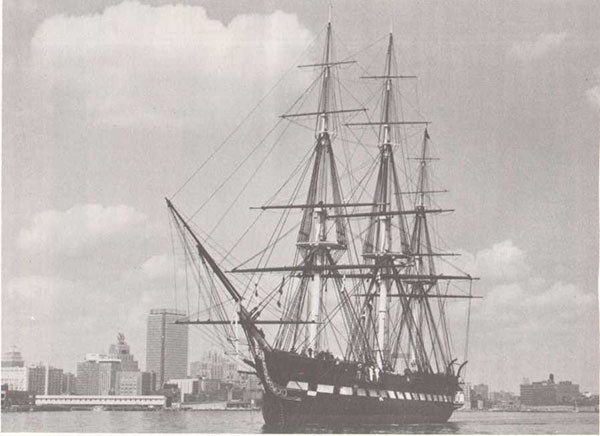
---11--
Adams, have joined to form the core of this Center. It is so very fitting that the Center be named to honor Commodore Dudley Knox, the naval officer who perhaps did more than any other individual to strengthen and reinforce the Navy's commitment to its historic heritage and traditions.
There is no more visible or recognizable embodiment of this heritage and naval traditions than USS Constitution, "Old Ironsides," permanently berthed at Boston, Massachusetts, the city where she was launched in 1797. The Director, Dudley Knox Center, Rear Admiral John D.H. Kane, Jr., is the Immediate Superior in Command of Constitution providing administrative and logistic support to the ship's on board commanding officer.
The Dudley Knox Center for Naval History, as structured to carry out its mission, embraces the Navy Department Library, the Navy Memorial Museum, and four Branches - Curator, Operational Archives, Research and Ships' Histories.
Today, the Navy Department Library shelves more than 150,000 volumes plus some 7,000 rare books and an extensive periodical, newspaper and
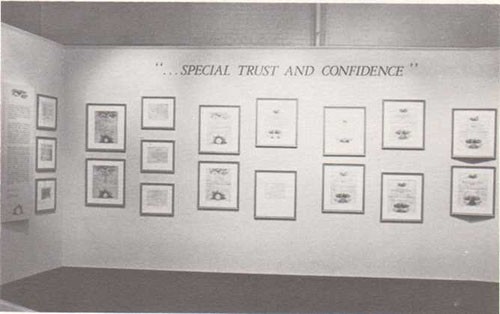
microfilm collection. Holdings cover all periods and all aspects - operational, administrative, biographical, scientific - of United States naval history, foreign naval material, current pertinent non-fiction literature and extensive reference sources. Illustrative of the fascinating rare books is Captain Thomas Truxtun's 1797 Instructions, Signals, and Explanation, offered for the United States Fleet; this is believed to be the only copy extant. The Library staff responds to some
--12--
10,000 requests for reference services and sends out about 1,500 volumes on inter-library loan each year. Uniformed personnel, civilian scholars, and the reading public are welcome to use the Library's facilities. The Director of the Dudley Knox Center has an additional assignment as Coordinator of Navy Libraries.
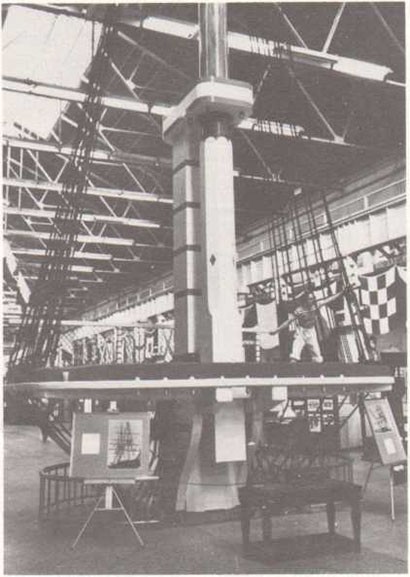
The U.S. Navy Memorial Museum welcomes 150,000 visitors a year. It is also the scene of numerous official functions. With the foretop from the USS Constitution installed as the Museum's centerpiece, the displays trace the history of the Navy from the American Revolution to the exploration of outer space and the ocean's depths. One unique display entitled "Special Trust and Confidence" presents naval officer commissions signed by every president from George Washington to Harry S. Truman. It is a "Hands on" museum where young visitors can train a World War II antiaircraft gun or sight through a submarine periscope.
All of the Center's resources are widely-used for reference, research and display purposes. The 200,000 historic photograph collection in the Curator Branch is a gold mine for anyone seeking illustrations for publication or any
--13--
variety of reasons. Historic artifacts in the Center's inventory - anchors, bells, guns, flags, uniforms, etc. - exceed 120,000 items. These are placed on loan throughout the country with museums, military activities, local governments, veterans groups, churches, and similar organizations authorized by law to receive such material on loan. Oil paintings and other naval art, under Center cognizance, hang in the White House, Tingey House (official quarters of the Chief of Naval Operations), the offices of Defense Department civilian and military officials, other government departments and throughout this Center.
From more than ninety depositories in as widely scattered locations as Venice, Italy, and San Marino, California, the Center's Research Branch has brought together copies of some half million manuscripts bearing on American Revolution naval operations. Included, for example, from the Public Record Office, London, are the logs of more than 250 Royal Navy ships actively engaged against the rebellious colonists. The entire growing collection, comprising in excess of 1,000 microfilm reels, makes available to researchers a national scholarly resource existing nowhere else in the world.
The Operational Archives, another of Commodore Knox's lasting contributions, continues to collect and service selected current records of historical value. Excellent guides have been developed for easy use of the holdings which measure about 9,000 feet. In addition to the official records and oral history transcripts, the Operational Archives Branch holds biographical data on many naval officers and papers from the immediate offices of senior naval officers. Extensive use of these collections is made for official purposes by individuals, Navy study groups, retired senior flag officers, and by visiting scholars and authors.
The Center's publication program is varied and designed to meet the needs of the naval service and schools, other governmental agencies, as well as the civilian specialist and reading public. Emphasis is placed on preparation of source material and reference-type volumes. Examples of the scope of publications are: Dictionary of American Naval Fighting Ships (8 volumes); Naval Documents of the American Revolution (8 volumes to date); U.S. Naval History Sources in the United States; United States Naval History, A Bibliography; The United States Navy and the Vietnam Conflict (2 volumes); The Naval War of 1812, Selected Documents (1 volume to date); At Close Quarters: PT Boats in the United States Navy; Autobiography of Rear Admiral Charles Wilkes, U.S. Navy, 1798-1877; United States Naval Operations in Korea; Civil War Naval Chronology, 1861-1865.2
2Copies of the Center's publications in print list are available upon request.
--14--
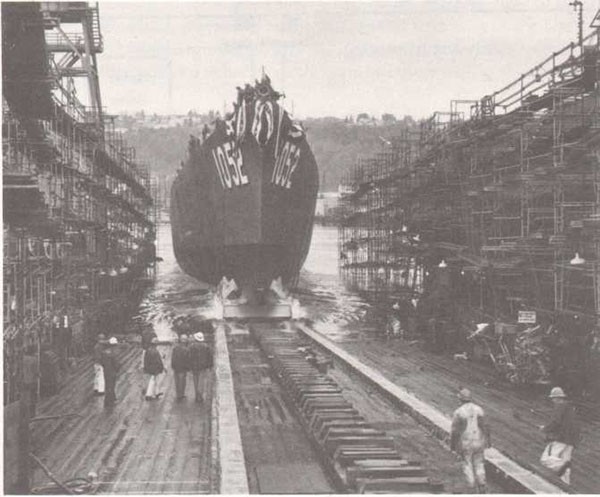
Still another of the interesting and demanding responsibilities staffed by the Ships' Histories Branch for the Center Director is to make appropriate recommendations to the Secretary of the Navy for the names of new construction ships and to nominate the lady who will sponsor, that is christen, the new ship at the time of launch.
All Branches of the Center are responsive to requests for information, guidance and assistance. Annually some 25,000 written, telephone and personal visit requests are received. Such requests can come from government officials, Congress, or the student doing a class paper. The professional expertise represented on the Center's staff, augmented by the various specialized resources, is available and utilized by scholars from all areas of this country and around the globe.
The Center provides office space for the Naval Historical Foundation [http://www.navyhistory.org/]. This is proper and welcome since Commodore Knox was the organization's principal mover when founded in 1926. Following his retirement from the Navy in 1946, he served the Foundation long and well, first as Secretary and later as President. The Naval Historical Foundation is chartered as a private, nonprofit, self-supporting organization dedicated to the "collection, acquisition,
--15--
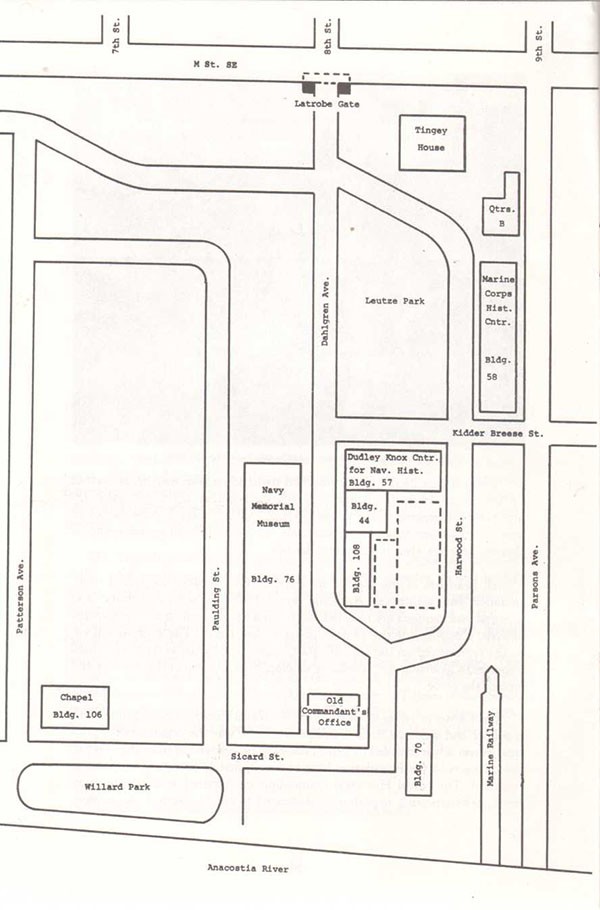
--16--
and the preservation ... of manuscripts, relics, books, pictures, and all other things and information pertaining to the history and traditions of the United States Navy and merchant marine, and the diffusion of knowledge respecting such history and traditions either by publication or otherwise."
The Foundation's collection of naval officers' personal papers, over 250 individual groupings extending from the American Revolution to the very recent past, physically housed in and serviced by the Manuscript Division, Library of Congress, is the largest such collection in existence. Represented in the group are papers of Stephen Luce, David Dixon Porter, John Rodgers, and William F. Halsey. A printed catalogue of the collection is available to assist the researcher. From time to time, the Naval Historical Foundation publishes interesting monographs which are distributed to the membership.
* * *
Visitors entering the Washington Navy Yard through the Latrobe Gate immediately come upon carefully maintained Leutze Park, the location for impressive ceremonies and observances. Residences of the Chief of Naval Operations and the Commandant, Naval District, Washington, the Marine Corps Historical Center and a spectacular collection of historic bronze guns rim the park, named for Rear Admiral Eugene Leutze who served as Yard Commandant early in this century.
Facing Leutze Park at its south end is building 57, one of three adjoining buildings which house the Dudley Knox Center for Naval History. The Center Director's office, Administration, Historical Research Branch, Ships' Histories Branch, a portion of the Operational Archives Branch (this Branch's voluminous records occupy the third deck of the three buildings) and the Naval Historical Foundation are in building 57. This building dates from 1866 and was enlarged about 1899 by extending westward on Kidder Breese Street to the Dahlgren Avenue corner where the Yard fire house previously stood for many years. Building 57 has been used, among other purposes, to store provisions and clothing, for ordnance inspection and an ordnance school, as a barracks, and most recently, Headquarters, Chesapeake Division, Naval Facilities Engineering Command.
The Navy Department Library runs the length of the first floor of buildings 44 and 108 with its easy access entrance at street level on Dahlgren Avenue. The Curator Branch, including Photographic Section, is in building 108. Both of these buildings, constructed in 1890 and 1902 respectively, have seen duty as shops and laboratories for ordnance related activities.
--17--
By necessity, the requirement for extensive floor space and room to expand dictates that the Navy Memorial Museum occupy a separate building. It is in another of the nineteenth century industrial buildings, at the waterfront, number 76, where breech mechanisms for heavy guns were manufactured. Overhead cranes, installed in the building to handle the great weights of gun components, are still used by the Museum staff to move and position large exhibits. Outdoor displays in Willard Park, adjacent to building 76, complement those on the Museum floor.
* * *
The Washington Navy Yard is the oldest shore activity in the naval establishment. It was authorized in 1799, the site was approved by President Washington and the master plans were drawn by the celebrated architect and engineer, Benjamin Latrobe. On 11 May 1976, the historic area within the Yard, termed the Historic Precinct, was designated a National Historical Landmark.
The main entrance to the Yard, beautiful Latrobe Gate dating from 1806, with Victorian additions made in the 1880s, remains as a memorial to Latrobe's
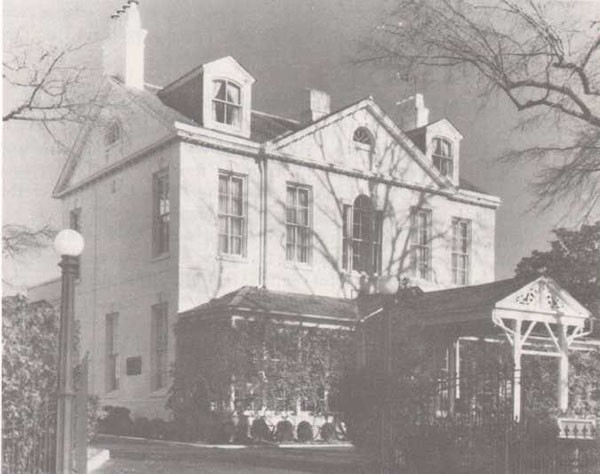
--18--
architectural art. During the Civil War, President Lincoln regularly dashed through the gate in carriage or on horseback to confer with Commander Dahlgren, Yard Commandant, on urgent naval matters. Many notables have passed through Latrobe Gate including England's King George VI and Queen Elizabeth on their state visit to Washington in 1939.
The Yard is studded with fascinating buildings representing various periods and architectural styles. Foremost among them is Tingey House, official quarters of the Chief of Naval Operations since 1977. The two and one-half story Georgian townhouse built in 1804 is named for Captain Thomas Tingey first commandant of the Yard who, except for one brief period, held the command for twenty-nine years, 1800-1829. Before construction of the house was authorized, Captain Tingey regularly appealed for suitable quarters to be "enabled (as I ought) to be always at my post, night and day." The Navy Yard was put to the torch in 1814 to prevent the facility and supplies from falling into British hands. Fortunately, the Commandant spared Tingey House from the flames.
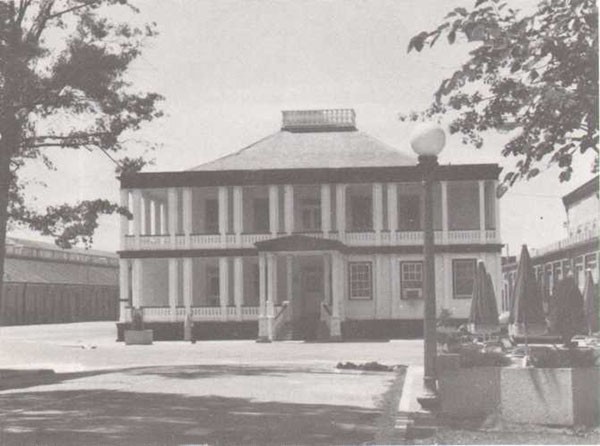
The oldest building still in use in the Yard surprisingly is not Tingey House. That distinction goes to Quarters B dating from 1801 or early 1802 as quarters for the Yard's second in command. It has been conjectured that the building was a farmhouse on the land purchased by the government for the Navy Yard.
--19--
Currently, the Commandant, Naval District, Washington, resides in Quarters B.
Still another of the Yard's landmark structures is the Commandant's Office constructed in 1837-38 which serves as a Visitor Information Center. It
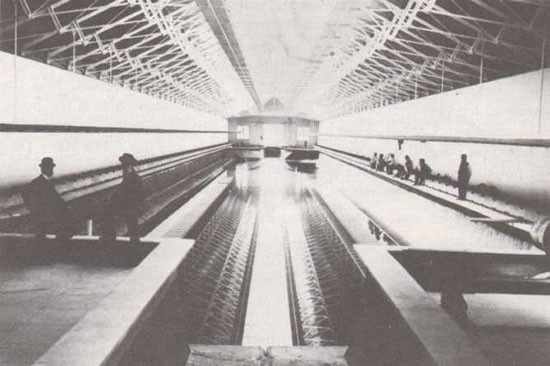
is a distinctive two story brick building with verandas running all around both floors and capped with a widow's walk. As envisioned by Benjamin Latrobe, the Yard's principal thoroughfare, now called Dahlgren Avenue, would slope gently down in a straight line from the main gate at the north to where the Commandant's Office now stands at the south. Like many of the Yard's buildings, the old Commandant's Office, building 123, has been used for a number of purposes through the years - post office, communication center, living quarters.
A small turn of the century forge shop, building 106, was renovated and converted to a handsome little chapel in 1973. This transformation was an all-volunteer effort by active duty and reserve naval personnel. Some 70 weddings and 25 baptisms are celebrated annually in the chapel.
The Washington Navy Yard has been the scene of numerous and significant technological achievements. Here Lieutenant John Dahlgren did his world-renowned ordnance work. Dahlgren's scientific measurements of barrel pressures resulted in his development of the bottle-shaped "Dahlgren Gun,"
--20--
mainstay of naval ordnance during the Civil War. Commodore John Rodgers, in 1822, designed and built the first marine railway in this country by which large naval ships could be hauled out of the water for repair or storage. One can still search out this inclined plane railway sandwiched between building 70 and Parsons Avenue.
Congress in 1896 appropriated funds to build a "Model Tank for Experiments" at the Washington Navy Yard. Noted naval architect and engineer David W. Taylor supervised construction of the nation's first model basin. A million gallons of water filled the basin which was 14 feet deep, 42 feet wide and 470 feet long. Experimental models in the basin were used to measure water
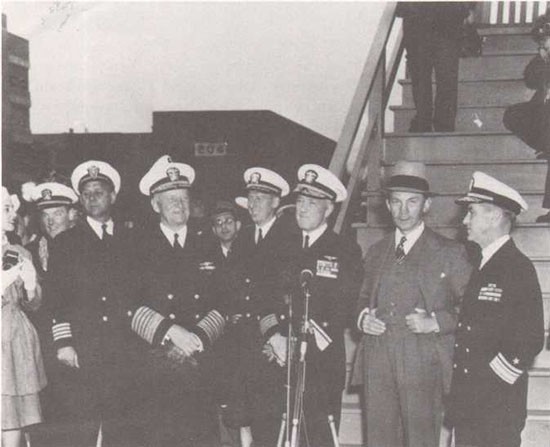
resistance on various hull configurations leading to major improvements in ship design and performance. Similarly, a wind tunnel, devised by Captain Taylor, provided scientific analysis for advances in aircraft design.
The old David Taylor Model Basin is in building 70. The basin itself has been covered over to form a level floor, and the building is used by the Center to store artifacts not on museum display.
--21--
Throughout its existence, the Navy Yard at Washington has welcomed distinguished guests and has been the stage for dramatic and historic events. As already noted in this account, President Lincoln was a familiar figure in the Yard. The Marquis de Lafayette and World War I commander French Marshal Joffre are listed among the visitors. Japan's first diplomatic mission to the United States landed here. The body of John Wilkes Booth, the Lincoln assassin, was brought to the Yard and medically examined on board a Navy monitor anchored in the Anacostia River. Raphael Semmes, captain of the celebrated Confederate commerce raider Alabama, was imprisoned in the Yard. The casket bearing the remains of the World War I Unknown Soldier was put ashore here from USS Olympia. Colonel Charles A. Lindbergh, after the first solo flight across the Atlantic, and Rear Admiral Richard E. Byrd, upon his return from Antarctica, landed at the Yard.
It is readily apparent that the Washington Navy Yard, ceremonial quarterdeck of the Navy in the nation's capital, has for almost two hundred years been intimately associated with our national and naval history. Thus, it is entirely fitting that this Yard should be the permanent home of the Dudley Knox Center for Naval History which is dedicated to the preservation, furtherance and dissemination of America's proud naval legacy.
--22--
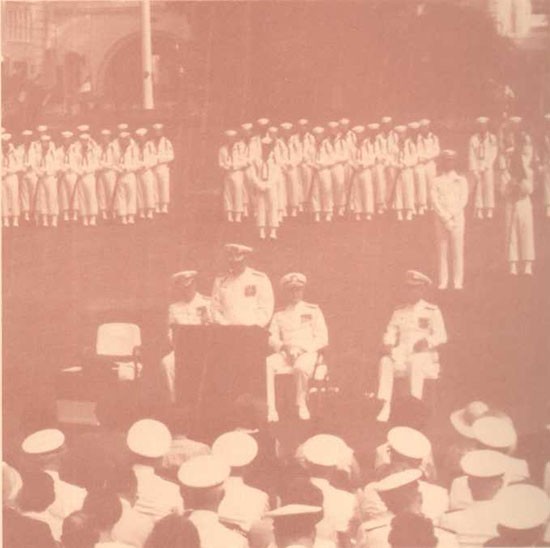
--End--



